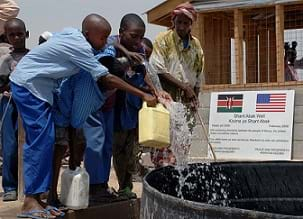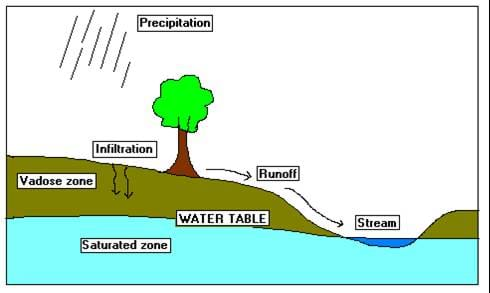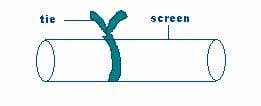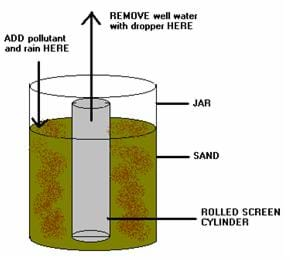Quick Look
Grade Level: 6 (5-7)
Time Required: 45 minutes
Expendable Cost/Group: US $3.50
Group Size: 3
Activity Dependency: None
Subject Areas: Earth and Space
NGSS Performance Expectations:

| MS-ESS3-3 |

Summary
Students learn about physical models of groundwater and how environmental engineers determine possible sites for drinking water wells. During the activity, students create their own groundwater well models using coffee cans and wire screening. They add red food coloring to their models to see how pollutants can migrate through the groundwater into a drinking water resource.Engineering Connection
Environmental engineers understand how water flows through the ground as they make physical models of groundwater flow to determine which aquifers can supply water to which communities. They must know how the groundwater travels so they can design pumps that can adapt to changes in water level, otherwise the wells may go dry. Environmental engineers also protect our drinking water by modeling contaminant transport in aquifers and designing ways to remove the contaminants.
Learning Objectives
After this activity, students should be able to:
- Compare a model of a groundwater well with what it represents.
- Model and observe how pollution travels to groundwater wells from the surface.
- Describe how engineers decide on the placement of a drinking water well.
- Describe technology used by engineers to get water from an aquifer to the surface.
Educational Standards
Each TeachEngineering lesson or activity is correlated to one or more K-12 science,
technology, engineering or math (STEM) educational standards.
All 100,000+ K-12 STEM standards covered in TeachEngineering are collected, maintained and packaged by the Achievement Standards Network (ASN),
a project of D2L (www.achievementstandards.org).
In the ASN, standards are hierarchically structured: first by source; e.g., by state; within source by type; e.g., science or mathematics;
within type by subtype, then by grade, etc.
Each TeachEngineering lesson or activity is correlated to one or more K-12 science, technology, engineering or math (STEM) educational standards.
All 100,000+ K-12 STEM standards covered in TeachEngineering are collected, maintained and packaged by the Achievement Standards Network (ASN), a project of D2L (www.achievementstandards.org).
In the ASN, standards are hierarchically structured: first by source; e.g., by state; within source by type; e.g., science or mathematics; within type by subtype, then by grade, etc.
NGSS: Next Generation Science Standards - Science
| NGSS Performance Expectation | ||
|---|---|---|
|
MS-ESS3-3. Apply scientific principles to design a method for monitoring and minimizing a human impact on the environment. (Grades 6 - 8) Do you agree with this alignment? |
||
| Click to view other curriculum aligned to this Performance Expectation | ||
| This activity focuses on the following Three Dimensional Learning aspects of NGSS: | ||
| Science & Engineering Practices | Disciplinary Core Ideas | Crosscutting Concepts |
| Apply scientific principles to design an object, tool, process or system. Alignment agreement: | Human activities have significantly altered the biosphere, sometimes damaging or destroying natural habitats and causing the extinction of other species. But changes to Earth's environments can have different impacts (negative and positive) for different living things. Alignment agreement: | Relationships can be classified as causal or correlational, and correlation does not necessarily imply causation. Alignment agreement: The uses of technologies and any limitations on their use are driven by individual or societal needs, desires, and values; by the findings of scientific research; and by differences in such factors as climate, natural resources, and economic conditions. Thus technology use varies from region to region and over time.Alignment agreement: |
Common Core State Standards - Math
-
Fluently add, subtract, multiply, and divide multi-digit decimals using the standard algorithm for each operation.
(Grade
6)
More Details
Do you agree with this alignment?
-
Find a percent of a quantity as a rate per 100 (e.g., 30% of a quantity means 30/100 times the quantity); solve problems involving finding the whole, given a part and the percent.
(Grade
6)
More Details
Do you agree with this alignment?
-
Solve real-world and mathematical problems involving the four operations with rational numbers.
(Grade
7)
More Details
Do you agree with this alignment?
International Technology and Engineering Educators Association - Technology
-
Devise strategies for reducing, reusing, and recycling waste caused from the creation and use of technology.
(Grades
6 -
8)
More Details
Do you agree with this alignment?
State Standards
Colorado - Math
-
Add, subtract, multiply, and divide decimals to hundredths.
(Grade
5)
More Details
Do you agree with this alignment?
-
Find a percent of a quantity as a rate per 100.
(Grade
6)
More Details
Do you agree with this alignment?
-
Solve real-world and mathematical problems involving the four operations with rational numbers.
(Grade
7)
More Details
Do you agree with this alignment?
Colorado - Science
-
Use evidence to model how water is transferred throughout the earth
(Grade
6)
More Details
Do you agree with this alignment?
-
Identify the various causes and effects of water pollution in local and world water distributions
(Grade
6)
More Details
Do you agree with this alignment?
Materials List
For each group:
- 4" by 4" square piece of fine wire screening
- twist tie (such as a garbage bag tie or plant/landscaping wire) for tying screens
- clear glass jelly jar (~1/2 pint) or coffee can
- 3-5 cups of playground sand (amount depends on the exact size of the jar/can)
- aluminum pie pan
- medicine dropper
- food coloring
- pencil
- cup of water
Introduction/Motivation
Natural underground aquifers are water sources located under all of the continents on the Earth. Groundwater is the water source that comes from aquifers below the Earth's surface (see Figure 1). In fact, more groundwater exists on the Earth than the amount of water in lakes and streams together. This water is a very important source of drinking water. States such as Florida obtain up to 97% of their clean water from the ground. The groundwater supply is tapped into by digging or drilling water wells. Environmental engineers design these drinking water wells and the treatment plants that go along with them.
Environmental engineers start by making physical models of groundwater flow to determine which aquifers can supply water to different communities. They analyze the physical properties of the groundwater to determine how safe it is and how it can be used.
For example, the level of water in a well does not always remain constant. Can you think of why this might happen? (Answer: Seasonal changes in infiltration capacity, hydraulic gradient, and precipitation may affect groundwater levels.) Engineers design pumps to get the water out of the well. These pumps need to take the changes in water level into consideration; otherwise, too much water could be pumped out and the well might go dry.

Engineers also look for neighboring landfills and industries to determine if contaminants are leaking into the groundwater and aquifers from these sources. Imagine a landfill, for example. If all sorts of garbage and waste are sitting in a pile in a landfill on the ground, what happens to the chemicals and contaminants when it rains? Harmful substances can be washed into the groundwater from landfill and garbage dumps during a rainfall.
Groundwater is also at great risk of pollution from other sources. Pollutants such as pesticides, chemicals and oil can migrate through the ground from runoff from agricultural fields and roadways. If not monitored, these contaminants can end up in our drinking water. Environmental engineers work to protect our drinking water, by sampling aquifers to test for contaminants and designing methods to remove the contaminants. Groundwater samples are collected from wells in the aquifer and tested for contaminants; this practice is called monitoring. The wells used to collect the samples are called monitoring wells. Removing contaminants from aquifers and treating those contaminants is called groundwater remediation.
Today we are going to act as environmental engineers and make physical models of drinking water wells. Then we will look at what happens when contaminants are spilled on the ground near our well. What do you think will happen?
Procedure
Before the Activity
- Gather all materials for students.
- Pre-cut the wire mesh/screening into 4" x 4" squares.
With the Students
- Review groundwater flow with students.
- Divide the class into groups of three students each and hand out materials to each group.
- Explain how to make a model well following the steps below. It may be useful to make an example in front of the class and then let students repeat the procedure in their small groups.
To make a model well:
- Roll the piece of screening around a pencil to make a cylinder (see Figure 2).

- Enlarge the cylinder to approximately one centimeter in diameter and secure at that diameter with the piece of wire or a twist tie (see Figure 3).

- Place the screen cylinder in the middle of the jar and hold it steady while pouring sand around the outside of the screen (see Figure 4).

To model a contaminated well:
- Ask students to determine a question about contaminants that they would like to answer during this investigation.
- Remind students that the sand in the jar/can is considered the land surrounding the well, and the wire mesh cylinder is the pump.
- Have students pour ½ cup water onto the sand in the jar.
- Ask students to use the medicine dropper to remove water from the well. This serves as their water "pump." Direct student to make observations of the "look" of this water (such as clear or cloudy.)
- Have students determine a "contamination site" in their jar—a spot where a landfill or chemical contaminants will be added to the model. Ask them to add five to six drops of food coloring as the "pollutant" to that sand site.
- Have students measure depth of the water well before the "rainfall," recording this number on a piece of paper.
- Then have students carefully add ½ cup "rain" water to the sand (their land) in the jar.
- Have them use the medicine dropper (pump) to remove a sample of well-water. Then make make observations of the condition of this water (such as colored or clear.)
- Have students measure depth of the well water after the "rainfall," recording this number on a piece of paper. How did the water level change? How would the water level change the amount of pumping that would be needed to get the water from the well? (Answer: Higher water levels are easier to pump.)
Assessment
Pre-Activity Assessment
Discussion: What do engineers need to consider when building a groundwater well? (Possible answers: Engineers need to know the water table height to determine how deep to dig the well, and what might be nearby sources of pollutants, such as industrial farms and roadways.)
Activity Embedded Assessment
Journals: Have students record their procedures, predictions, observations and conclusions in their journals. Ask them to be very thorough and complete.
Question/Answer: Ask the following questions:
- What happened to the groundwater when you removed water from the well? (Answer: The level of the water in the jar went down.)
- What happened to the well water when the "pollution" was added to the "soil?" (Answer: The water in the well turned the same color as the pollution added.)
- How does the water table change? (Answer: The water table increases in height after a "rain" and decreases height when water is pumped from the well.)
- Have groups calculate the percent change of water depth in their well after the rainfall. [(final depth - initial depth)/(initial depth) * 100] What does this value say about the amount of water in the well? (Answer: After rainfall, the amount of water in the well should increase.)
Post-Activity Assessment
Inform the Community! Have student groups create an informational flyer to illustrate how pollutants move from ground surface to aquifer to drinking well. Awareness of pollutant sources can help us minimize their impact on the environment. Pass the flyer to another group (the community) and have the second group write on the back of the flyer one compliment, one criticism, and one question. Pass the flyers back and talk about the questions as a group. Display the flyers around the room or school to inform other members of the community.
Monitor and Minimize Human Impact! Imagine that a manufacturing facility (which uses many chemicals) is built near a neighborhood that relies groundwater for its drinking water. You must develop a plan to 1) install monitoring wells and 2) collect groundwater samples from the monitoring wells to make sure that chemicals from the manufacturing facility don't contaminate the drinking water wells. Where would you locate the monitoring wells relative to the manufacturing facility and the neighborhood? (Draw a map to help explain.) How frequently would you sample the wells?
Troubleshooting Tips
Pouring sand can be messy, so place pie pans under the jars/cans to collect stray sand so it doesn't scatter all over the table and floor.
Watch that students do not use medicine droppers as water guns.
Alert students to be careful with the food coloring because it stains skin and clothing.
Activity Extensions
For extra well water work, have student groups use a tub or large plastic container to create an area with several wells. Add pollution at one end of the "land" and see how much "rain" and time it takes to get the pollution to all the wells. Draw a diagram of your well area and how the water flowed in it. Try changing the spacing of the wells and repeat the activity.
Activity Scaling
For younger students, have them draw the path of pollution to drinking water well on a print out of a water table diagram (from above) after completing the activity.
For older students, have them add different amounts of food coloring "pollutants" starting with one drop to 10 drops. After each drop, add one tablespoon of "rain." Each time a drop of pollution and rain is added, measure well water color with dropper and record. Have students graph their data and describe how different amounts of "pollution" are affected by rainfall.
Subscribe
Get the inside scoop on all things TeachEngineering such as new site features, curriculum updates, video releases, and more by signing up for our newsletter!More Curriculum Like This

Students learn about several possible scenarios of contamination to drinking water, which comes from many different sources, including surface water and groundwater. They analyze the movement of sample contaminants through groundwater, in a similar way to how environmental engineers analyze the phys...

In this lesson, students learn about the three methods of waste disposal in use by modern communities. They also investigate how engineers design sanitary landfills to prevent leachate from polluting the underlining groundwater.

Students learn how water flows through the ground, what an aquifer is, and what solid properties predict groundwater flow. Groundwater is one of the largest sources of drinking water, so environmental engineers need to understand groundwater flow in order to tap into this important resource.

Students learn about contamination and pollution, specifically in reference to soil in and around rivers. Student groups use color sensors to take light reflection measurements of different colors of sand (dyed with various amounts of a liquid food dye), generating a set of "soil" calibration data. ...
References
U.S. Environmental Protection Agency, Underground Injection Control (UIC) Program. Accessed November 2, 2005. http://www.epa.gov/safewater/uic.html
Copyright
© 2005 by Regents of the University of Colorado.Contributors
Malinda Schaefer Zarske; Janet Yowell; Melissa StratenSupporting Program
Integrated Teaching and Learning Program, College of Engineering, University of Colorado BoulderAcknowledgements
The contents of this digital library curriculum were developed under grants from the Fund for the Improvement of Postsecondary Education (FIPSE), U.S. Department of Education and the National Science Foundation (GK-12 grant no. 0338326). However, these contents do not necessarily represent the policies of the Department of Education or National Science Foundation, and you should not assume endorsement by the federal government.
Last modified: April 14, 2019









User Comments & Tips